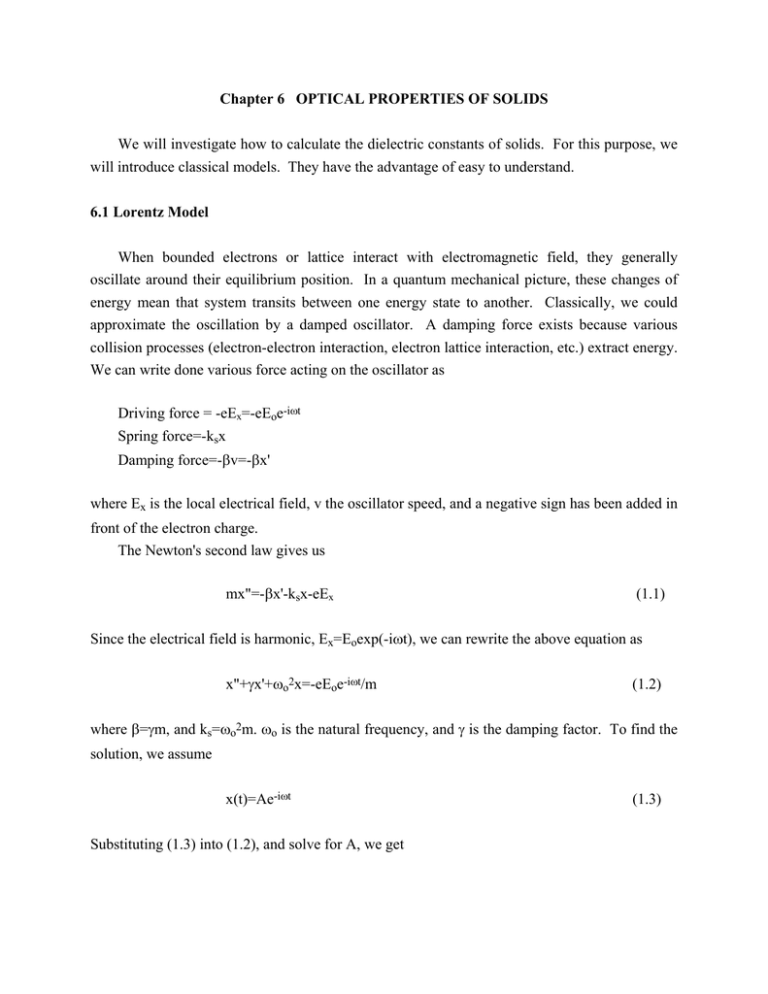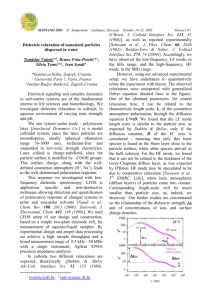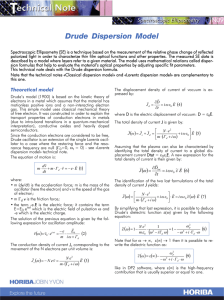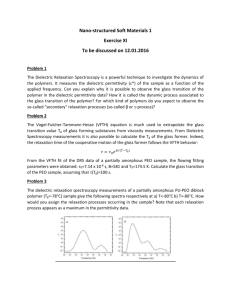Chapter 6 OPTICAL PROPERTIES OF SOLIDS
advertisement

Chapter 6 OPTICAL PROPERTIES OF SOLIDS We will investigate how to calculate the dielectric constants of solids. For this purpose, we will introduce classical models. They have the advantage of easy to understand. 6.1 Lorentz Model When bounded electrons or lattice interact with electromagnetic field, they generally oscillate around their equilibrium position. In a quantum mechanical picture, these changes of energy mean that system transits between one energy state to another. Classically, we could approximate the oscillation by a damped oscillator. A damping force exists because various collision processes (electron-electron interaction, electron lattice interaction, etc.) extract energy. We can write done various force acting on the oscillator as Driving force = -eEx=-eEoe-iωt Spring force=-ksx Damping force=-βv=-βx' where Ex is the local electrical field, v the oscillator speed, and a negative sign has been added in front of the electron charge. The Newton's second law gives us mx"=-βx'-ksx-eEx (1.1) Since the electrical field is harmonic, Ex=Eoexp(-iωt), we can rewrite the above equation as x"+γx'+ωo2x=-eEoe-iωt/m (1.2) where β=γm, and ks=ωo2m. ωo is the natural frequency, and γ is the damping factor. To find the solution, we assume x(t)=Ae-iωt Substituting (1.3) into (1.2), and solve for A, we get (1.3) A=− eEo 1 2 m ωo − ω 2 − iγω (1.4) and e −i ωt eEo x(t) = m ω o2 − ω 2 − iγω (1.5) Recall that ex is the polarization of one oscillator. The total polarization per unit volume is thus ωp N e2 E e − iωt = 2 εoE P=Noex = o o 2 2 m ωo − ω − iγω ωo − ω 2 − iγω (1.6) N o e2 ω = mε o (1.7) 2 where 2 p We will see the origin for this name later. The polarization is related to the electrical field through the electrical permittivity, P=xεoE (1.8) ω 2p x= 2 ω o − ω 2 − i γω (1.9) So we have The relative dielectric constant (ε=εoεr) is εr = 1 + χ = 1 + ω 2p = ε'r + iε "r 2 2 ω o − ω − iγω where the real and the imaginary parts are (1.10) ω 2p (ω o2 − ω 2 ) εr = 1 + 2 (ω o − ω 2 )2 + γ 2 ω 2 (1.11) ω 2p γω εi = 2 (ω o − ω 2 )2 + γ 2 ω 2 (1.12) The complex refractive index is calculated from εr as N = εr (1.13) n2-k2=εr' (1.14) 2nk=εr" (1.15) or Classically, ωo is the resonance frequency of the simple harmonic oscillator. Quantum mechanically, the ωο is the energy difference between the final and the initial states. If we have multiple oscillator, the Lorentz model can be written as ε r = 1+ ∑ 2 j ω oj ω 2pj − ω 2 − iγ j ω (1.16) Drude Model For metals, there is no spring to connect free electrons to ions, so ωo=0. From the Lorentz model, we get εr = 1 − ω 2p ω 2 + iγω (1.17) The real and the imaginary parts are εr ' = 1 − ω 2p ω2 + γ2 (1.18) and ε r" = ( ω 2p γ ω ω2 + γ 2 ) (1.19) These results are called Drude model. Generally, ωp>γ. If ω>ωp, we can see that εr"-->0, which means that κ-->0. At high frequency, there is no absorption. A metal becomes transparent! The reason is that at this frequency, the electrons in the metal cannot react fast to the incident electrical field. Example: Self-Extinction of a Laser-Induced Plasma In laser material processing, the ablated and/or evaporated materials are often ionized. An ionized gas is called plasma. If the laser frequency is smaller than the plasma frequency, there will be high reflection of the laser beam and the laser energy cannot reach the target. We always want to operate in the transparent region, ω> ω p = N o e2 mε o (1.20) This leaves an upper limit for the total number of the ionized particles in the plume No < ω 2 mε o e2 (1.21) Hagen-Rubens Equation We can further relate the metal dielectric constant to it electrical conductivity. From our derivation or the Lorents model, we have the electron location as a function of the time. We can calculate the electron speed as eEo (−iω )e − iωt v=x=− m −ω 2 − iγω • Let's consider the DC limit, ω-->0, then (1.22) v= eE (1.23) mγ The current flux density can be calculated from the electron velocity J=Noev=σdcE (1.24) From Eq. (1.23) and (1.24), we can get calculate the damping factor from its dc conductivity 2 σ dc Ne 2 ω p ε o = = mγ γ (1.25) We can use the above relation to calculate γ and substitute into the Drude model to calculate n and κ. A further approximation is obtained observing the Drude expression, when ω-->0, we have ω 2p εr ' = n − κ = 1 − 2 ≈1 − 2 ω + γ2 γ 2 ε r" 2 ω 2p ω 2p γ ω 2p = 2nκ = ≈ ω (ω 2 + γ 2 ) ωγ (1.26) (1.27) From this, we can see that ω 2p 0.003λ σ dc n≈k= = = 2ωγ 2ωε o ρ dc (1.28) The above relation is called Hagen-Rubens relation. Induced Field Effects In the derivations of the Lorentz model and the Drude model, we assume that the local electrical field acting on an atom equals the externally applied electrical field. By doing so, we assumed that the neighboring atoms have no effect on the atom we are considering. We can then calculate an the electrical dipole momentum of the atom caused by the external field. But such a dipole will generate electrical field itself. The generated electrical field is superimposed with the external field and applied to other atoms. Similarly, the atom we are considering also experience the electrical field generated by other atoms in the surrounding. So, strictly speaking, the electrical field acting on the atom, Elocal we are considering consists of two parts, one is the external electrical field Eex, the other is the field induced by the polarization of other atoms. Elocal=Eex+Eind (1.29) It can be proven that the induced field is related to the polarization as Eind=P/3εo (1.30) (ε − ε 0 )Eex = P (1.31) We also know that, From the above three equations, we obtain, Elocal = ε + 2ε o Eex 3ε o (1.32) Now let's revisit the Lorentz model, we have obtained that ω p2 P= 2 ε E = χε o Elocal ωo − ω 2 − iγω o local (1.33) We also have, from definition, D = ε Eex = ε 0 Eex + P (1.34) Thus, ε − εo = or ε + 2ε o 3 χ (1.35) ω 2pj ε r − 1 ( n + ik )2 − 1 1 = = ∑ ε r + 2 ( n + ik )2 + 2 3 j ω oj2 − ω 2 − iγ j ω (1.36) where the summation is a generalization to several oscillators as we generalization the Lorentz model. The above relation is called Clausius-Mossotti relation. Its significance lies in that it relates the dielectric constant, which is a macroscopic quantity, to the microscopic quantity of the oscillators. It can be further shown that the above equation can also be written as ε r = 1+ ∑ 2 j Ωoj ω 2pj − ω 2 − iγ j ω (1.37) This expression is identical to our derivation for the Lorentz model except that we changed ωo to Ωo, their relation is Ω 2oj = ω 2oj − ω 2pj 3 (1.38) But this does not matter for most experiment since the value of ωo is often obtained by matching the experimental results with the models. When ω<<ωo, we can neglect the ω terms in the denominator. In this case, the right hand side of Eq. (1.37) is independent of frequency and linearly proportional to the square of the plasma frequency. But since square of the plasma frequency is proportional to the number of oscillators, which is proportional to the density, we have εr − 1 = ρ • cons tan t εr + 2 (1.39) In this case, the frequency is far from the resonant frequency, the absorption is zero, we can rewrite is as n2 − 1 1 = constan t n2 + 2 ρ (1.40) Lorenz-Lorentz equation. This equation gives us a relation between density and the refractive index. It is particularly useful for some experiment which use the change of the refractive index caused by density change such as the shadow graph, the interferometer methods to measure temperature distribution. For gases, we can even approximate the expression future because n~1. We have n −1 ρ = constan t (1.41) Debye Relaxation There is another mechanism for polarizing matter containing permanent, as opposed to induced, electric dipoles. Such permant dipoles already exist in the materials such as the water molecules. Only these dipoles are randomly oriented. When an electromagnetic field is applied, these dipoles will be realigned towards the direction of the electromagnetic field. Unlike the Lorentz model, in which a spring will drag a polarized oscillator back to it equilibrium position, the restoring force is random thermal motion and it only tries to randomize the dipole orientation. To further understand the difference, imagine that we have an oscillation electromagnetic field that applied to a Lorents oscillator and a polarized molecule. When the electromagnetic field is turned off, the oscillator in die down in an oscillating fashion, but for the permanent dipole, the change is no external force to force its dipole into a specific direction, it will try to randomize its direction. Such a randomization is called relaxation. We could express the relaxation process as Pd(t)=Pd(0)e-t/τ (1.42) τ-relaxation time or time constant. For fluids, this relaxation time can be calculated from a simple model, which consider the relaxation time of a sphere of radius d in a fluid of viscosity µ, τ= πµd 3 2κ BT (1.43) Based on the described process, we can also relate the polarization with the external field and get an expression for the dielectric constant, which is ε = 1 + χv + χ D − χv 1 − iωτ (1.44) where χv is the electrical susceptibility at high frequency side (due to lattice vibration) and cD is the electric susceptibility at low frequency side. We can further write the expression in terms of n and k as 2 2 n −k = nv2 n2D − nv2 + 1 + ω2 τ2 (1.45) ωτ (n2D − nv2 ) 2 nκ = 1 + ω 2τ 2 (1.46) The Debye relaxation generally occurs at very long wavelength (microwave frequency) because an order of estimation of the relaxation time shows that τ is in the 10-10-10-12 s, which corresponds to microwave frequency. At higher frequency, the molecules cannot follow the fast oscillation of the electromagnetic fields. Now we should have a full picture of the dielectric constant of materials. Please look at the extinction coefficient of water. Kramer-Kronig Relations Our discussion on the optical properties of solids will be complete with one more topic, this is the Kramer-Kronig relation. This relation is a mathematical result that relative the real and the imaginary parts of any complex functions, including the dielectric constant, the refractive index, the complex reflection coefficient. In fact, from our previous discussions, we can see that once dielectric function is determined, the real and the imaginary parts are automatically determined. A more fundamental result is that as long as the function is an analytical function, their real and imaginary parts are interrelated. The relation between the real and the imaginary parts for dielectric constants are called Kramer-Kronig relations. We can write such a relation for the n and κ as n(ω ) = 1 + k(ω ) = 2 π 2 π ∞ ω' k( ω' ) 2 dω 0 ω ' −ω P∫ 2 n(ω ' ) 2 2 dω 0 ω' − ω ∞ (1.47) (1.48) P∫ where P signifies the Cauchy principal value of the integral because the denominator in the integrand experience a zero, ∞ ω ' k( ω' P∫ 0 ω' 2 −ω ) 2 dω = lim ω −a ∫ 0 ∞ ω' k(ω ' ) ω ' k(ω ' ) 2 2 dω + lim ∫ 2 2 dω ω ' −ω ω +a ω ' −ω (1.49) We can also write a similar relation for the reflection coefficient. From our discussion on the Fresnel reflectivity, as know that R = | r12 |2 (1.50) Or we could write the reflection coefficient as r12 = R(ω )ei ϕ ( ω ) (1.51) In practice, we can measure the reflectivity easily but not the phase. Since r12 is an analytical function, its amplitude and phase also obeys the Kramer-Kronig relation. We can use the relation to calculate the phase from measured reflectivity ϕ (ω ) = 2ω π R(ω ' ) dω ' ω ' −ω 2 ∞ ln P∫ 0 2 (1.52) Once we calculate the phase, we know the reflection coefficient, from which we can inverse the Fresnel relation to get n and k. The advantage of the Kramer-Kronig relation is that it does not depend on any mathematical model for the dielectric constants. The disadvantage of the relation is that the integration is always over the whole spectrum. In rarely cases, we can measure one property over the whole spectrum. What is common in practice is that people measure reflectivity in certain frequency ranges, and for the reflectivity out side this frequency range, they use some model based on our previous discussions. Then they use the Kramer-Kronig relations for the consider range to derive n and k in this range. The idea is that outside the measurement region, the accuracy of the guessed function does not affect the accuracy of the measured range because the denominator becomes vary large and the contribution from their integration is small.





